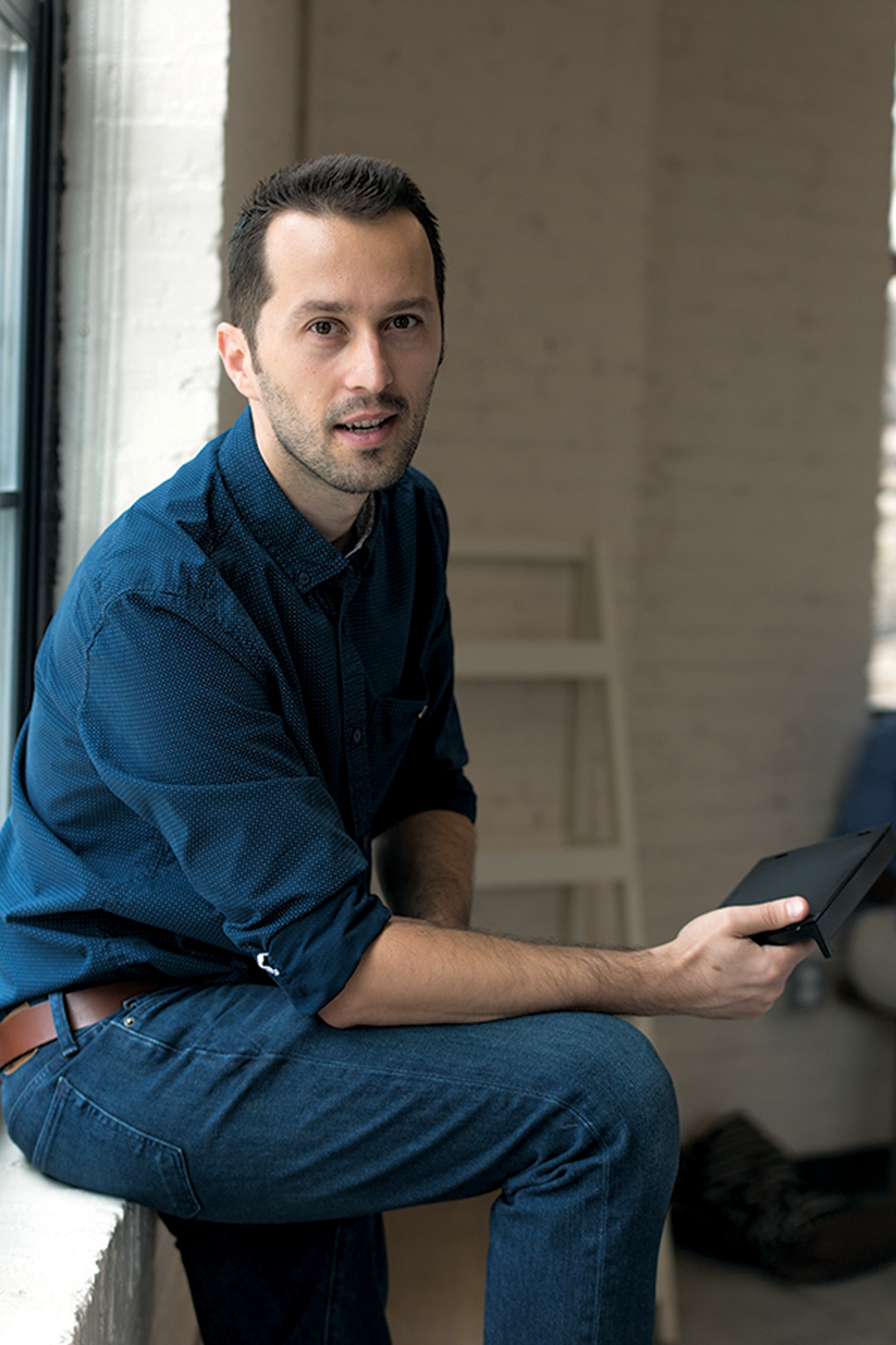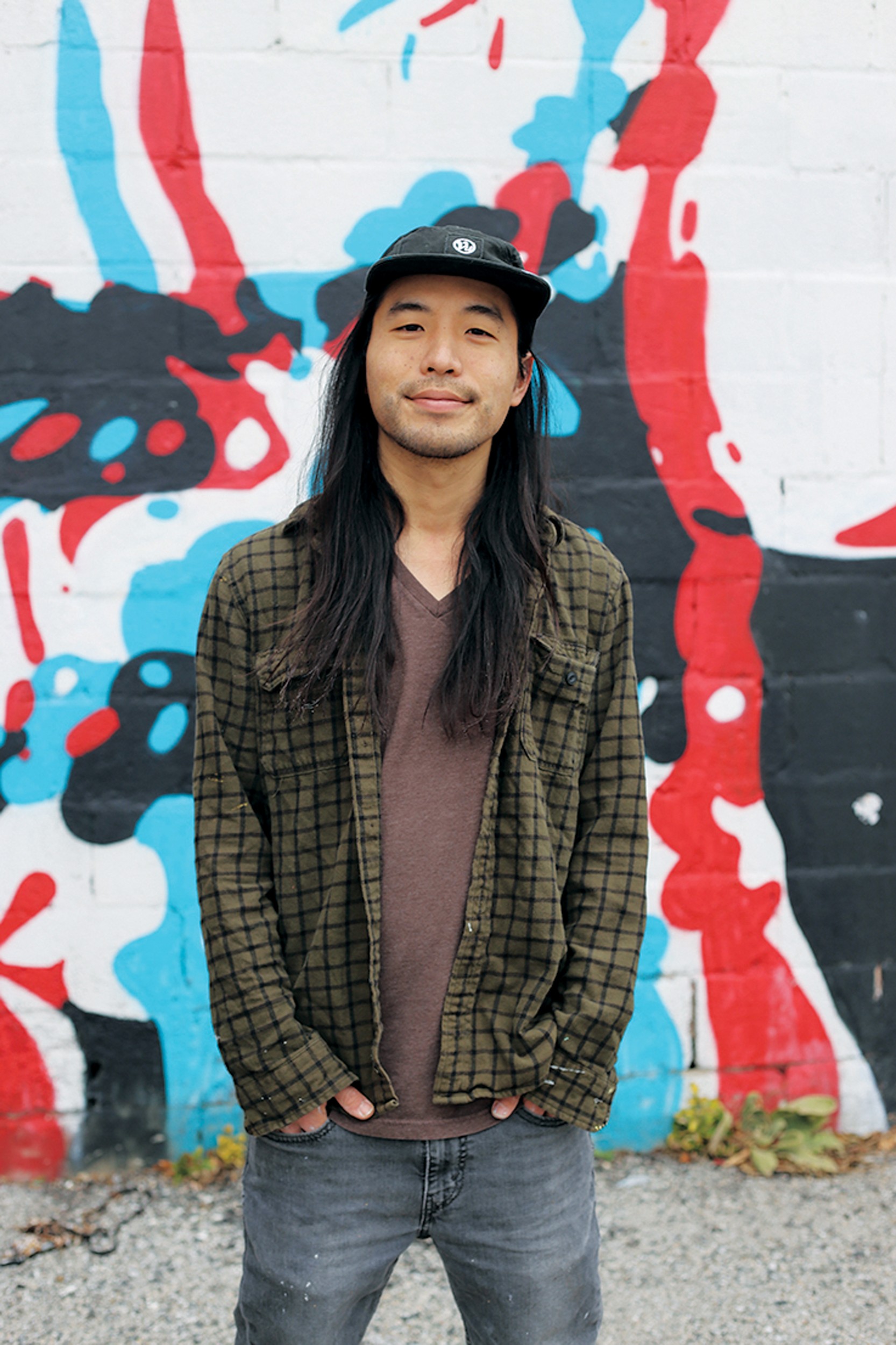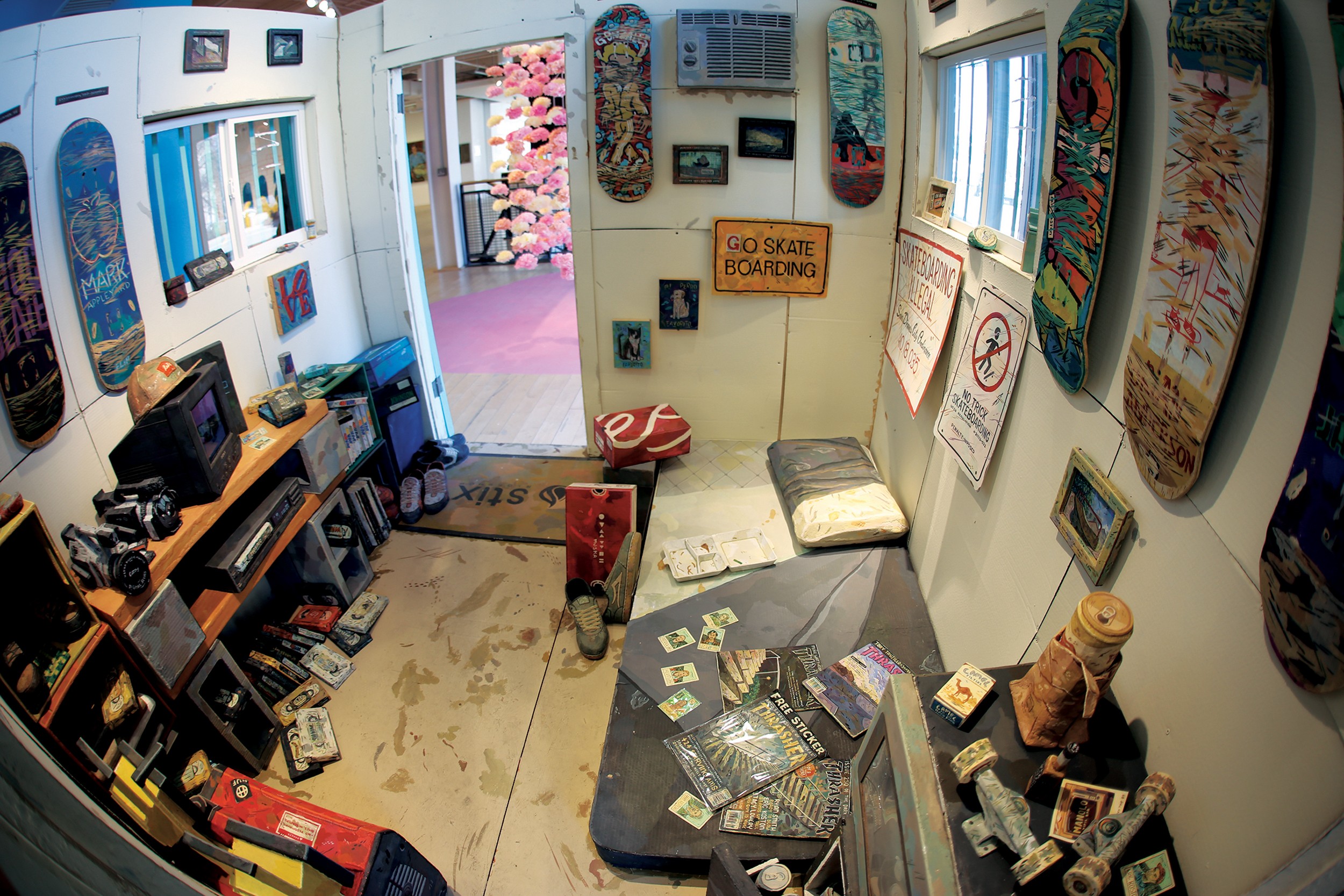Illustrators are natural storytellers; but across media, their work has traditionally been used to play a supporting role — to add depth to the written word.
MICA is flipping that paradigm.Here, students in illustration practice are urged to reinvent their work and their way of thinking. They break existing rules and they are finding new and unconventional ways to make illustration central to the story instead of an auxiliary component.
Edon Muhaxheri ’17 and Ryan Cho ’18 are prime examples of this new normal. Each has created work where imagery is the main event, illuminating culture and history to tell stories in ways that words simply cannot.
Edon Muhaxheri ’17
 It looked like a fairytale,” Edon Muhaxheri ’17 said, recalling the moment his life took a 180-degree turn. “The indication that it was over was people falling from the sky. Paratroopers were arriving.”
It looked like a fairytale,” Edon Muhaxheri ’17 said, recalling the moment his life took a 180-degree turn. “The indication that it was over was people falling from the sky. Paratroopers were arriving.”
It was June 1999 and Muhaxheri was 13 years old. He had just spent 78 days isolated with 29 people in two one-bedroom apartments during NATO’s intervention in the Kosovo War.
And he was an ethnic Albanian in Serbia — whose government, under president Slobodan Milošević, spent decades culturally oppressing its Albanian population in the disputed province of Kosovo. School was improvised, for example, because Albanians were forbidden an education. Classes were held in secret — sometimes at night in Serbian school buildings where bribes opened doors after dark.
This was life for Muhaxheri. This was normal. Until the day the sky rained soldiers.
“When you get used to something, you get comfortable with it. And then all of a sudden, everything changes.It was like starting a different life,” he explained.
Muhaxheri embraced that different life with a hustle and drive that still define him today. “A lot of funds were coming in, internationally, to get things back in order,” Muhaxheri said. “Children were working. I started my career when I was 14 as an illustrator and animator.”
He worked in advertising for several years and went on to earn an undergraduate degree in multimedia and graphic communications. He worked at Walt Disney World in Orlando through a college program. Back home, he founded an advertising agency that was eventually bought by Ogilvy & Mather, an event considered the peak of his career at the time.
“Growing up like I did made me understand the importance of education and the importance of work,” he said.
When he came to MICA in 2015, he already had 15 years of professional experience under his belt.
During his first year here, Illustration Practice faculty member Kimberly Hall challenged new students to produce work that could be sold at MICA’s annual Art Market. She wanted to push students out of their comfort zone. Muhaxheri decided to make an automaton, a mechanical carousel toy that revolved.
“It was ridiculous and funny, because making pink and baby blue horses for a little toy was not my thing. But during the process, I fell in love with designing the mechanism of the automaton,” Muhaxheri recalled.
He became obsessed and discovered that complicated automata as seen in the movie “Hugo” — humanoid machines that write — were built in the 1800s by Swiss and French clockmakers. He noted, “Most of those automata have over 6,000 tiny pieces that work together.”
His carousel had 36.
When it came time to pursue his thesis, faculty pushed him toward automata. “I had to come up with a narrative because I’m in illustration. I couldn’t just make a mechanical device,” he said. “I’m Albanian, so I thought my automaton could write something in my language.”
Because automata were a phenomenon in the 1800s, he looked at Albanian culture during that era and quickly found his inspiration. “The first primer, the first ABC book written in Albanian, was written in 1844 by Naum Bredhi. Somehow, I would link my automaton to that book.”
As he researched, Muhaxheri discovered something truly fantastic: the alphabet used in that first ABC book was the only such alphabet created specifically for the Albanian language.
Muhaxheri explained, “When I write my name in the Latin alphabet [used by most Western countries], I have to add a lot of different letters for you to pronounce it phonetically. This Albanian alphabet corresponds to the sounds that Albanians make.”
He found a number of sources that mentioned the alphabet, but he couldn’t find images. One of his last resorts was to contact the Museum of
Education in Albania. “I wasn’t optimistic, to tell you the truth. But I called and they said, ‘Yes, we have a copy of the primer. Do you want us to scan it for you?’ I was blown away.”
The Albanian primer was written in both Greek and the Albanian alphabet, called Vithkuqi. Muhaxheri connected Greek letters with their Albanian counterparts, eventually decoding the lost alphabet.
 Over time, Muhaxheri has taken the advice of international alphabet experts, revising the alphabet so that some letters have changed.
Over time, Muhaxheri has taken the advice of international alphabet experts, revising the alphabet so that some letters have changed.
His thesis changed. Instead of focusing solely on an automaton, Muhaxheri also digitized the alphabet into Albanian Helvetica so that Albanians around the world can use it. And when Kosovo’s ambassador to the U.S. visited MICA to hear Muhaxheri’s thesis presentation, her subsequent tweet reached 100,000 people. The discovery of Albania’s lost alphabet has made Muhaxheri a celebrity among native Albanians. Shows displaying the automaton and alphabet are planned for Kosovo and Albania, as well as a permanent display at the Museum of Education that sent him a copy of the primer. Muhaxheri reflected, “Going to another country to study was nothing. I went through a war. But I brought my culture with me. This project has to do with bringing Kosovo here with me. I constantly try to promote my culture. I think it means helping my people,” he said.
“Already, people back home are using the alphabet. They’re making tattoos with the letters. They send me pictures of their children trying to learn these letters. This is amazing.”
Ryan Cho ’18
 Skate decks, sneakers, videotapes and a VHS player, digital video cameras and copies of Thrasher magazine are some of the objects you’ll find in Ryan Cho’s studio in the Lazarus Center. The lifelong skater surrounds himself with familiar objects from the not-too-distant past of his youth, each chosen for its specific memory. But, the skating ephemera is not what it seems; each object is a hand-constructed objet d’art, made by Cho from a cardboard skeleton and papier-mâché covering and hand-painted to finish.
Skate decks, sneakers, videotapes and a VHS player, digital video cameras and copies of Thrasher magazine are some of the objects you’ll find in Ryan Cho’s studio in the Lazarus Center. The lifelong skater surrounds himself with familiar objects from the not-too-distant past of his youth, each chosen for its specific memory. But, the skating ephemera is not what it seems; each object is a hand-constructed objet d’art, made by Cho from a cardboard skeleton and papier-mâché covering and hand-painted to finish.
Cho, a second-year Illustration Practice M.F.A. student who came to MICA from skating mecca Los Angeles, decided to use his thesis project as a way to pay homage to the skating culture of his youth and the carefree spirit it embodies.
“People move to California from all over the U.S. and the world to live the romanticized life of skating every day and making ends meet somehow,” remarked Cho. “As a teenager in the late 1990s, I remember idolizing a neighborhood skateboarder who had no money, no job, slept in his parents’ basement and lived off of the McDonald’s Dollar Menu. It wasn’t the most glamorous life, but he skated every day and was sponsored to do it.”
To capture this idealized SoCal lifestyle, Cho’s thesis project incorporates his collection of skating objects into a micro-house installation, titled “roll thru,” which, when presented together, will create a unique snapshot of the life of an everyday skater.
Inspired by life-sized installations such as Lucy Sparrow’s “8 ’Till Late,” which recreated a typical New York City bodega but was stocked entirely with objects made of felt and the Clayton Brothers’ “Wishy Washy,” an illustrative take on a neighborhood laundromat, Cho’s installation allows viewers to fully experience the life of a skater of a previous era.
“I wanted to speak about the skateboarding subculture, but could not visualize it in a book format. The building installation is crammed with the valuables and junk that revolve around this sort of life and I was drawn to the idea of the audience building their own narrative based on the objects present,” said Cho.
This is not the first time Cho’s passion for skating has influenced his work. Past projects include “vú,” a limited edition zine about an outsider entering Baltimore’s skate scene; “Froot Skoot,” a vintage-style scooter made from fruit crates that was the precursor to the contemporary skateboard; and “Cuddy Skateshop,” a miniature cardboard skateshop model made in a first-year paper cutting workshop at MICA.
“I like to believe that the act of creating work and the act of skating are parallel: you are constantly looking for different ways to create or solve something.”
It was through the paper cutting workshop that Cho began to think outside the traditional scope of illustration and how he could expand the concept to incorporate three-dimensional elements. It just happens that skateboarding was the key to expanding his illustrative practice.
“Skateboarders generally tend to have a D.I.Y. attitude. If they want to skate something, they’ll make it happen,” explained Cho.
“I guess that sort of hands-on, build-it-yourself approach has seeped into my illustrative work. I tend to gravitate towards work that involves constructing something rather than just drawing or painting.”

Beyond capturing the joie de vivre and romance of life as a skater, Cho’s installation also recalls a golden era of skateboarding on the cusp of mainstream popularity, a time when skating was still an outsider subculture. With growing worldwide visibility — skateboarding will be included in the summer Olympics for the first time in 2020 and skate magazine VICE is now one of the largest media brands in the world — Cho feels that a part of skating’s D.I.Y. identity is missing.
By inviting viewers into the microcosm of his fictional skater, Cho hopes his own nostalgia will impart to viewers the lifestyle of skating, rather than skating as a spectator sport or corporate enterprise.
“I want to preserve a point in time just before the skating scene became highly saturated. There is no room for a cult-like mindset anymore, where people watch the same videos religiously. Each big video used to define its own era and canon in skateboarding history. Now, there is content being uploaded every second on social media. College students are watching competitive skate events at sports bars. Skating’s rich subculture has become watered down due to its newfound easy accessibility. My installation is an ode to this disappearing subculture.”
